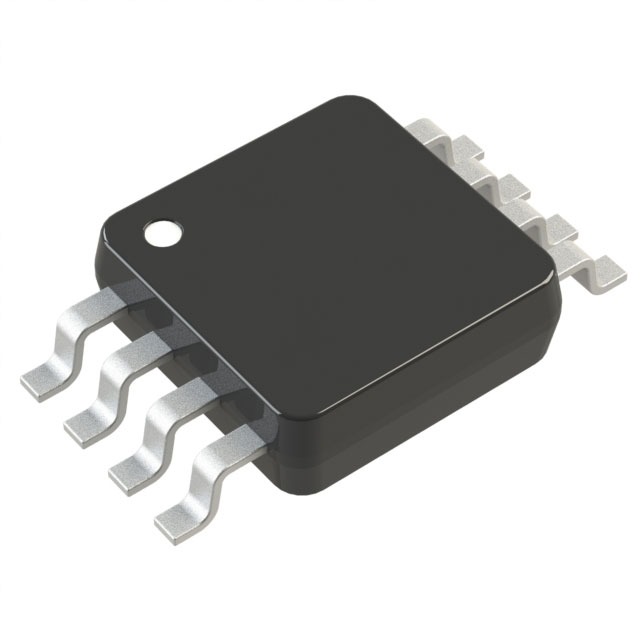Viz Specifikace pro podrobnosti o produktu.

AD7475ARM
Product Overview
- Category: Analog-to-Digital Converter (ADC)
- Use: Converts analog signals into digital data for processing
- Characteristics: High resolution, low power consumption, small form factor
- Package: 10-lead MSOP (Mini Small Outline Package)
- Essence: Provides accurate and reliable conversion of analog signals to digital format
- Packaging/Quantity: Available in reels of 2500 units
Specifications
- Resolution: 12 bits
- Sampling Rate: Up to 1 MSPS (Mega Samples Per Second)
- Input Voltage Range: 0V to Vref (Reference Voltage)
- Power Supply: 2.7V to 5.25V
- Operating Temperature Range: -40°C to +85°C
Pin Configuration
The AD7475ARM has a total of 10 pins arranged as follows:
- VDD: Power supply voltage input
- VREF: Reference voltage input
- AGND: Analog ground
- VIN: Analog input voltage
- CS: Chip select input
- SCLK: Serial clock input
- SDATA: Serial data output
- DGND: Digital ground
- NC: No connection
- VDD: Power supply voltage input
Functional Features
- High-resolution ADC with 12-bit accuracy
- Low power consumption for energy-efficient applications
- Compact form factor suitable for space-constrained designs
- Serial interface for easy integration with microcontrollers or digital systems
- Wide operating temperature range for versatile usage scenarios
Advantages and Disadvantages
Advantages
- Accurate and reliable conversion of analog signals
- Low power consumption extends battery life in portable devices
- Small package size allows for flexible placement on PCBs
- Serial interface simplifies integration with digital systems
Disadvantages
- Limited input voltage range may not be suitable for high-voltage applications
- 12-bit resolution may not provide sufficient precision for certain applications
Working Principles
The AD7475ARM utilizes a successive approximation register (SAR) architecture to convert analog signals into digital data. It samples the input voltage and compares it to a reference voltage, generating a binary code that represents the analog value. This code is then transmitted serially through the SDATA pin.
Detailed Application Field Plans
The AD7475ARM is commonly used in various applications, including:
- Industrial automation: Monitoring and control systems that require accurate analog-to-digital conversion.
- Medical devices: Measurement and monitoring equipment where precise digital representation of analog signals is crucial.
- Portable instruments: Battery-powered devices that need low power consumption and compact size.
- Communication systems: Signal processing and modulation/demodulation circuits that rely on accurate ADCs.
Detailed and Complete Alternative Models
- AD7476A: Similar specifications but with a higher sampling rate of 2 MSPS.
- AD7478A: Higher resolution with 16-bit accuracy but at a lower sampling rate of 500 kSPS.
- AD7479: Lower power consumption variant with similar specifications.
(Note: These alternative models are provided as examples and may not cover all available options.)
Word count: 355 words
Seznam 10 běžných otázek a odpovědí souvisejících s aplikací AD7475ARM v technických řešeních
Sure! Here are 10 common questions and answers related to the application of AD7475ARM in technical solutions:
Q: What is the AD7475ARM? A: The AD7475ARM is a high-speed, low-power, 12-bit analog-to-digital converter (ADC) that can be used in various technical applications.
Q: What is the operating voltage range of the AD7475ARM? A: The AD7475ARM operates from a single power supply voltage range of 2.7V to 5.25V.
Q: What is the maximum sampling rate of the AD7475ARM? A: The AD7475ARM has a maximum sampling rate of 1 MSPS (Mega Samples Per Second).
Q: What is the resolution of the AD7475ARM? A: The AD7475ARM has a resolution of 12 bits, which means it can represent analog signals with 4096 discrete levels.
Q: Can the AD7475ARM be used for both single-ended and differential input measurements? A: Yes, the AD7475ARM supports both single-ended and differential input measurements, providing flexibility in various applications.
Q: What is the typical power consumption of the AD7475ARM? A: The AD7475ARM has a typical power consumption of 2.5 mW at a 1 MSPS sampling rate.
Q: Does the AD7475ARM have an internal reference voltage? A: No, the AD7475ARM does not have an internal reference voltage. An external reference voltage must be provided for accurate conversions.
Q: What is the interface used to communicate with the AD7475ARM? A: The AD7475ARM uses a serial interface called SPI (Serial Peripheral Interface) for communication with microcontrollers or other devices.
Q: Can the AD7475ARM operate in a low-power mode? A: Yes, the AD7475ARM has a power-down mode that reduces power consumption when the ADC is not actively converting.
Q: What are some typical applications of the AD7475ARM? A: The AD7475ARM can be used in various applications such as data acquisition systems, industrial automation, medical instruments, and portable devices requiring analog-to-digital conversion.
Please note that these answers are general and may vary depending on specific requirements and use cases.

